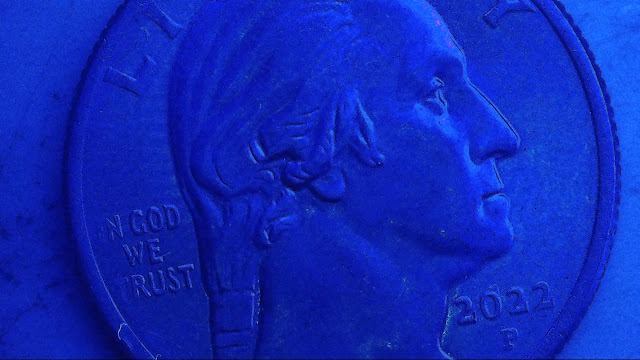 |
| Normal 2022 P Quarter Viewed Under Black Light. |
I recently mentioned an article from Numismatic News telling how coin experts and authenticators use fluorescent light to view coins. ( See Fluorescent Light Coin Examinations - Numismatic News)
The author said, Now, you’ll get no argument from me that bagmarks, scratches and hairlines are the easiest to see when you tip and rotate a coin in a dark room using incandescent light as is done in every professional grading room, but the glare from that light can hide friction on the high parts of the coin’s design. A stereomicroscope is the “equalizer.” Anything that can be seen using incandescent light can also be seen (plus more) by using fluorescent light, both eyes and the microscope. That’s why I examine just about every coin I grade with both a 7X hand lens under a 100 watt incandescent light and a 7X scope illuminated with fluorescent light. I like to see all the coin’s attributes. The only advantage of fluorescent light used with a hand lens is the ability to see rub (loss of luster) on a coin’s high points that is hidden by the glare from a light bulb! Give it a try. |
| Same 2022 P Quarter Photographed Using Incandescent Light Coming From An Angle. |
So far I don't see anything that jumps out when I use fluorescent light on the quarter. It might be missing something that an expert eye would see. But my experiment has just begun.
I found a good article on detecting fake coins. Here are a couple paragraphs.
When two dealers get together to discuss a suspect coin you’ll often hear them mention a rough, granular surface or pimples. These characteristics are commonly found on fakes made by casting.
More recently, they are seen on fakes struck using dies made by a spark erosion process. Many of the new Chinese counterfeit coins have these defects and they cannot be polished off without affecting the coin’s design. Do you see the tiny pimples in each of the micrographs?
One note of caution is in order. I have found that sooner or later, every defect seen on a counterfeit will turn up on a genuine coin and the reverse is also true. For instance, environmental damage can give a genuine coin a rough granular appearance and a few stray pimples on a coin does not prove it’s a counterfeit. In fact, one variety of 1883-CC Morgan dollar is covered with little pimples on its reverse.
And here is a link to read more.
Here is that link.
Canadian archaeologists recover 275 artifacts from Arctic shipwreck (msn.com)
---
So I'll be experimenting with fluorescent lighting on coins, and I'll be talking about 16th Century New World reales.
Good hunting,
Treasureguide@comcast.net
